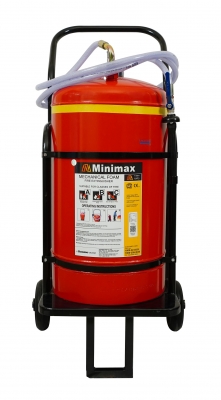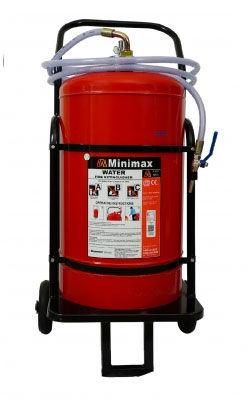Mechanical Foam Mobile Type

| Specifications | 20 Ltrs | 60 Ltrs |
| Fire Rating | 20A 233B | 20A 233B |
| Working Temperature °C | +5 °C to + 55 °C | |
| Effective Discharge | Minimum 95% | |
| Burst Pressure | 55/80 bar min., 110 bar (actual) approx | |
| Cylinder Testing Pressure | 35 bar for 30 sec. | |
| Jet Length | 6 mtr. | 10 mtr. |
| Min. Effective Discharge Time | 25 sec. | 40 sec. |
| CO2 Gas Cartridge | 250 gms. | 300 gms. |
| Charge | Water with AFFF 6% / AR-AFFF 6X6% | |
Minimax Mechanical foam (AFFF) Mobile Type extinguishers are ideal for installation in outdoor environments. These fire extinguishers are preferred in warehouses, petrol filling areas and factories where there is a dual risk of solid materials and flammable liquid fires. They can be used on both Class A (ordinary solids) and Class B (flammable liquids) fires containing materials such as wood, paper and other solid combustibles as well as flammable liquids including petrol and spirits.
AFFF fire extinguisher after operating on fire prone area produces a layer which helps in cooling as well as blanketing effect results in extinguishing fire. Another key property of the foam is its ability to seep its way into absorbent fuel sources which prevents reigniting risks. Mechanical foam fire extinguishers carry a yellow colour band which is clear and easy to see in the event of any emergency.
Look For More
FAQ's
- Class A, B and C Fire Hazard – Fire Extinguisher within 15 m travel distance.
- Class D, F and Special Fire Hazard – Fire extinguisher within 10 m travel distance.





